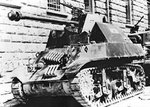Since M3 medium, followed by M4 were to be 'proper' tanks, you can change/develop M3 light tank to be better suited for WW2 battlefield. Starting point can be US entrance in war; M3 is already in combat in N. Africa, using both US and UK/Commonwealth products for improvement. The 1st usage of new tanks/derivatives circa late summer of 1943 (invasion of Italian 'boot').
No Cold War guns, thankyou
No Cold War guns, thankyou




